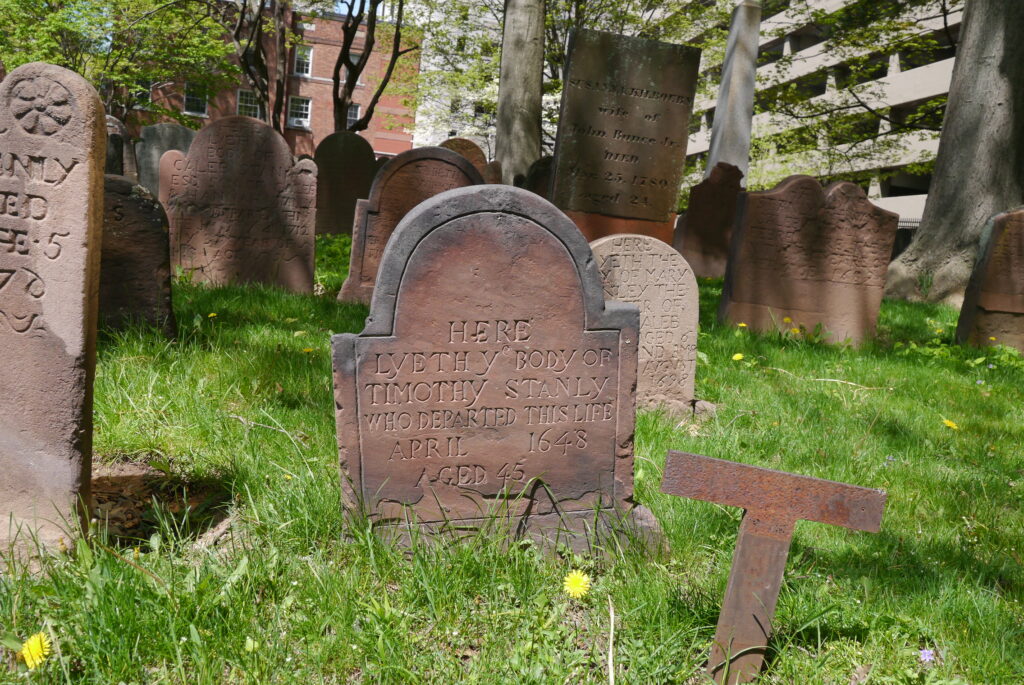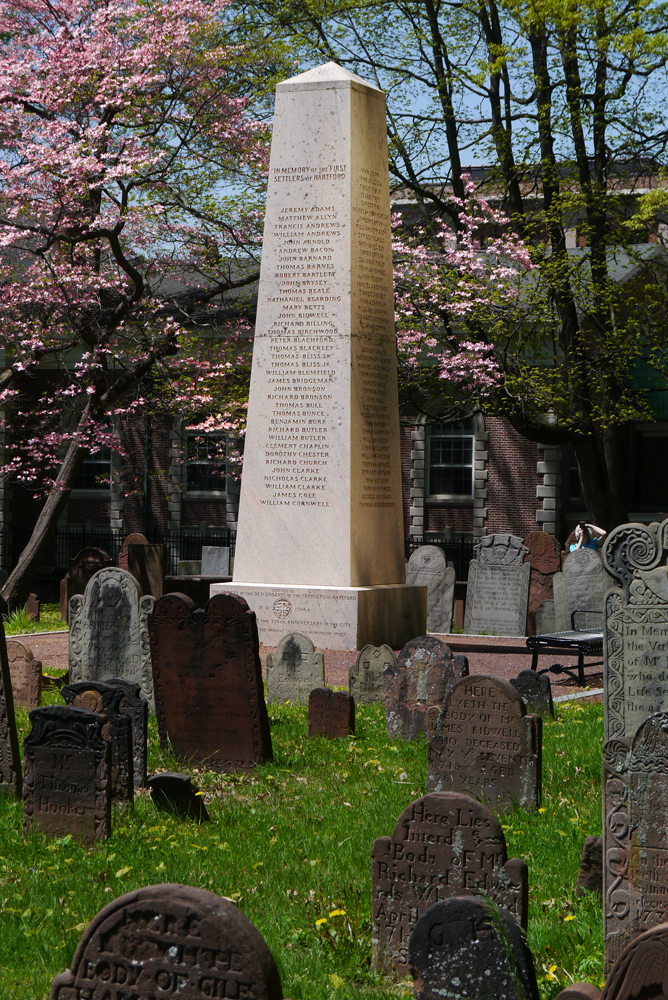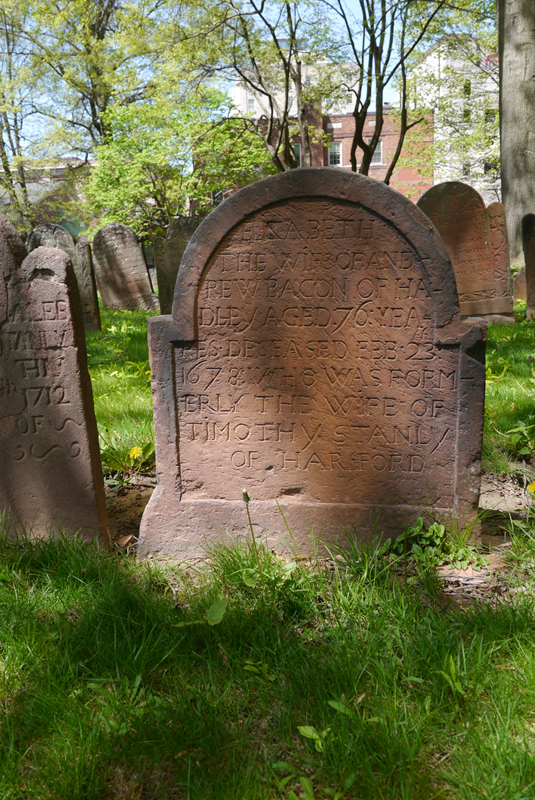
The Ancient Burying Ground of Hartford, Connecticut,1 one of America’s oldest cemeteries, is tucked beside a historic downtown church2 and surrounded by insurance company office towers and state government buildings. This is the final resting place of many of the city’s founding settlers, and a tall monument lists their names.3 Several, including Bull, Bunce and Mygatt, are on my family tree, but it is the name Stanley that interests me most. Hartford settlers Timothy Stanley (c. 1603-1648) and his wife Elizabeth (c. 1602-1678) were my direct immigrant ancestors.
Three brothers, John, Thomas, and Timothy Stanley, with their wives and children, set sail for America from England in 1634. They were part of a wave of strongly religious Puritan settlers who came to New England because they disagreed with the Church of England. Their father, Robert Standly (c 1570-1605), was a whitesmith (meaning he made things out of metal) in Tenterden, Kent, in the southeast of England.4 Their mother’s name was probably Ruth.
It could not have been an easy voyage for this extended family because John, the eldest of the brothers, died at sea, leaving his three young children to be raised by Thomas and Timothy. The Stanley family spent about two years in Cambridge, Massachusetts where Timothy was granted six acres of land and was named a freeman and admitted as a member of the Congregational church.5
Some Cambridge residents complained that there wasn’t enough land for all the new settlers. Then, after Pastor Thomas Hooker had a dispute with Massachusetts Bay Colony governor John Winthrop, Hooker and about 100 parishioners followed the old Indian trails south to the spot on the Connecticut River (also known as the Great River) that became Hartford.6

Timothy Stanley quickly established himself as a successful farmer in Hartford, and when a land inventory was taken in 1639, he held nine parcels of land of varying sizes. His house lot, including outhouses and gardens, was about two acres, on the west side of Front Street and with a view of the river. Later, he also bought property in Farmington, about 10 miles away.
The Stanley house was described in 1670 as follows: “It is a small, two-storey building, having on the first floor only the hall and “kitchinn”, the latter serving alike for a cook-room, living-room and parlor. Meager enough is the furniture: a deal table with a “form” or bench for sitting upon at meals, and standing in winter before the great open fireplace….. Such a luxury as a carpet is unknown.” 7
Timothy and his wife Elizabeth (whose maiden name is unknown) had seven children. The two eldest, Joseph and Timothy, were born in England; both died very young. Elizabeth, Abigail, Caleb (my direct ancestor), Lois and Isaac were all born in Hartford.8 Timothy also raised his niece Ruth.
Timothy was active in the community. He served on several juries, he served as a Hartford selectman (town official) and was on a committee to distribute land.
As Puritans, their religious beliefs were central to their lives. Puritans believed that man was inherently sinful. Even though they were unworthy, God chose to save some people and to send others to hell, and there was nothing anyone could do to change this. They believed everything happened for a reason. Meanwhile, the Puritans believed in hard work, and in the importance of education.9

Timothy died in April, 1648, at age 45. The inventory of his estate, taken on Oct 16, 1648, totalled £332, of which £167 represented the value of his real estate. The inventory counted household goods such as a bedstead and pillows, a hall chest, kettles and dishes, several books, a warming pan and two muskets. The farm animals included six oxen, several cows, a horse, sheep, pigs and bees.10 The court ordered that all his children be awarded something from his estate, while the house and lands in Hartford went to son Caleb.
In 1661, the widowed Elizabeth married Andrew Bacon and she inherited Andrew’s land in Hadley, MA when he died eight years later. By 1671, when she made out her will, she had returned to Hartford to stay with son Caleb’s family. Elizabeth Bacon died in 1678, around age 76.
While many of Hartford’s early settlers moved to other Connecticut towns, my direct ancestors stayed in Hartford for several generations. Eventually, great-grandson Timothy Stanley moved to Harwinton, CT and then to Wethersfield, and his son, Timothy Jr., settled in Litchfield, CT. Perhaps there are more family graves waiting to be found in Connecticut.
all photos by Janice Hamilton
This article also appears on the collaborative blog https://genealogyensemble.com
See also:
“The Elusive Pamela Stanley,” Writing Up the Ancestors, Sept. 28, 2018, https://www.writinguptheancestors.ca/2018/09/the-elusive-pamela-stanley.html
“Timothy Stanley Jr., Revolutionary Martyr,” Writing Up the Ancestors, Nov. 15, 2013, https://www.writinguptheancestors.ca/2013/11/timothy-stanley-jr-revolutionary-martyr.html
“My Line in the Stanley Family,” Writing Up the Ancestors, Oct. 30, 2018, https://www.writinguptheancestors.ca/2018/10/my-line-in-stanley-family.html
Sources:
- Ancient Burying Ground http://theancientburyingground.org
- First Church of Christ in Hartford, established 1632 www.centerchurchhartford.org/about.history.asp
- Society of the Descendants of the Founders of Hartford, www.foundersofhartford.org
- Leslie Mahler, “Re-Examining the English Origin of the Stanley Brothers of Hartford, Connecticut: A Case of Invented Records,” The American Genealogist, vol. 80, July, 2005, p. 218. www.Americanancestors.org, accessed July 24, 2013.
- Robert Charles Anderson, The Great Migration: Immigrants to New England, series 2, vol. VI, Boston: New England Historic Genealogical Society, 2009. 463.
- David M. Roth, Connecticut: A History. American Association for State and Local History, New York: W. W. Norton & Co., 1979, 39.
- Israel P. Warren, compiler. The Stanley Families of America as descended from John, Timothy and Thomas Stanley of Hartford, CT, 1636. Portland, Maine: printed by B. Thurston & Co., 1887, 228.
- Anderson, 465.
- Francis J. Bremer, Puritanism: A Very Short Introduction, New York: Oxford University Press, 2009, 43.
- Warren, 226.
